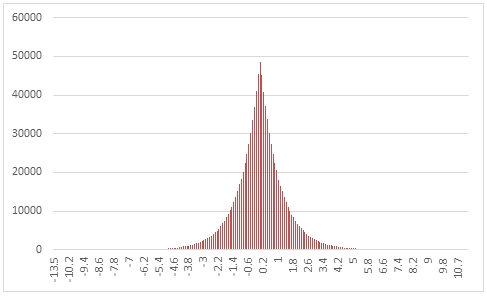SQL Server RANDLAPLACE Function
Updated 2023-10-18 15:57:47.273000
Description
Use the table-valued function RANDLAPLACE to generate a sequence of random numbers from a LaPlace distribution with parameters @Location and @Scale.
Syntax
SELECT * FROM [westclintech].[wct].[RANDLAPLACE](
<@Rows, int,>
,<@Location, float,>
,<@Scale, float,>)
Arguments
@Rows
the number of rows to generate. @Rows must be of the type int or of a type that implicitly converts to int.
@Location
the location parameter. @Shape must be of the type float or of a type that implicitly converts to float.
@Scale
the scale parameter. @Scale must be of the type float or of a type that implicitly converts to float.
Return Type
table
{"columns": [{"field": "colName", "headerName": "Name", "header": "name"}, {"field": "colDatatype", "headerName": "Type", "header": "type"}, {"field": "colDesc", "headerName": "Description", "header": "description", "minWidth": 1000}], "rows": [{"id": "d9a02b24-dde7-40da-86b5-4907819dfe96", "colName": "Seq", "colDatatype": "int", "colDesc": "A monotonically increasing sequence number"}, {"id": "29c8d09b-7d2e-42af-97a7-8f92d8423b89", "colName": "X", "colDatatype": "float", "colDesc": "The random variable"}]}
Remarks
@Scale must be greater than zero.
If @Shape is NULL then @Shape is set to 0.
If @Scale is NULL then @Scale is set to 1.
If @Rows is less than 1 then no rows are returned.
Examples
In this example we create a sequence 1,000,000 random numbers rounded to one decimal place from a Laplace distribution with @Location = 0 and @Scale =1, COUNT the results, paste then into Excel, and graph them.
SELECT X,
COUNT(*) as [COUNT]
FROM
(
SELECT ROUND(X, 1) as X
FROM wct.RANDLAPLACE( 1000000, --@Rows
0, --@Loations
1 --@Scale
)
) n
GROUP BY X
ORDER BY X;
This produces the following result.

In this example we generate 1,000,000 random numbers from a LaPlace distribution with @Shape of 5 and @Scale of 2. We calculate the mean, standard deviation, skewness, and excess kurtosis from the resultant table and compare th ose values to the expected values for the distribution.
DECLARE @size as int = 1000000;
DECLARE @location as float = -5;
DECLARE @scale as float = 4;
DECLARE @mean as float = @location;
DECLARE @var as float = 2 * POWER(@scale, 2);
DECLARE @stdev as float = SQRT(@var);
DECLARE @skew as float = 0;
DECLARE @kurt as float = 3;
SELECT stat,
[RANDLAPLACE],
[EXPECTED]
FROM
(
SELECT x.*
FROM
(
SELECT AVG(x) as mean_LAPLACE,
STDEVP(x) as stdev_LAPLACE,
wct.SKEWNESS_P(x) as skew_LAPLACE,
wct.KURTOSIS_P(x) as kurt_LAPLACE
FROM wct.RANDLAPLACE(@size, @location, @scale)
) n
CROSS APPLY
(
VALUES
('RANDLAPLACE', 'avg', mean_LAPLACE),
('RANDLAPLACE', 'stdev', stdev_LAPLACE),
('RANDLAPLACE', 'skew', skew_LAPLACE),
('RANDLAPLACE', 'kurt', kurt_LAPLACE),
('EXPECTED', 'avg', @mean),
('EXPECTED', 'stdev', @stdev),
('EXPECTED', 'skew', @skew),
('EXPECTED', 'kurt', @kurt)
) x (fn_name, stat, val_stat)
) d
PIVOT
(
sum(val_stat)
FOR fn_name in ([RANDLAPLACE], [EXPECTED])
) P;
This produces the following result (your result will be different).
{"columns":[{"field":"stat"},{"field":"RANDLAPLACE","headerClass":"ag-right-aligned-header","cellClass":"ag-right-aligned-cell"},{"field":"EXPECTED","headerClass":"ag-right-aligned-header","cellClass":"ag-right-aligned-cell"}],"rows":[{"stat":"avg","RANDLAPLACE":"-4.99944519359237","EXPECTED":"-5"},{"stat":"kurt","RANDLAPLACE":"3.01552778472663","EXPECTED":"3"},{"stat":"skew","RANDLAPLACE":"-0.00631324114182914","EXPECTED":"0"},{"stat":"stdev","RANDLAPLACE":"5.65406406691652","EXPECTED":"5.65685424949238"}]}
See Also
LAPLACEINV - Calculate the inverse lower cumulative distribution of the Laplace distribution.
RANDBETA - Random numbers from a beta distribution
RANDBINOM - Random numbers from a binomial distribution
RANDCAUCHY - Random numbers from a Cauchy distribution
RANDCHISQ - Random numbers from a chi-squared distribution
RANDEXP - Random numbers from an exponential distribution
RANDFDIST - Random numbers from an F-distribution
RANDGAMMA - Random numbers from a gamma distribution
RANDLOGISTIC - Random numbers from a logistic distribution
RANDNORMAL - Random numbers from the normal distribution
RANDPOISSON - Random numbers from a Poisson distribution
RANDSNORMAL - Random numbers from the standard normal distribution